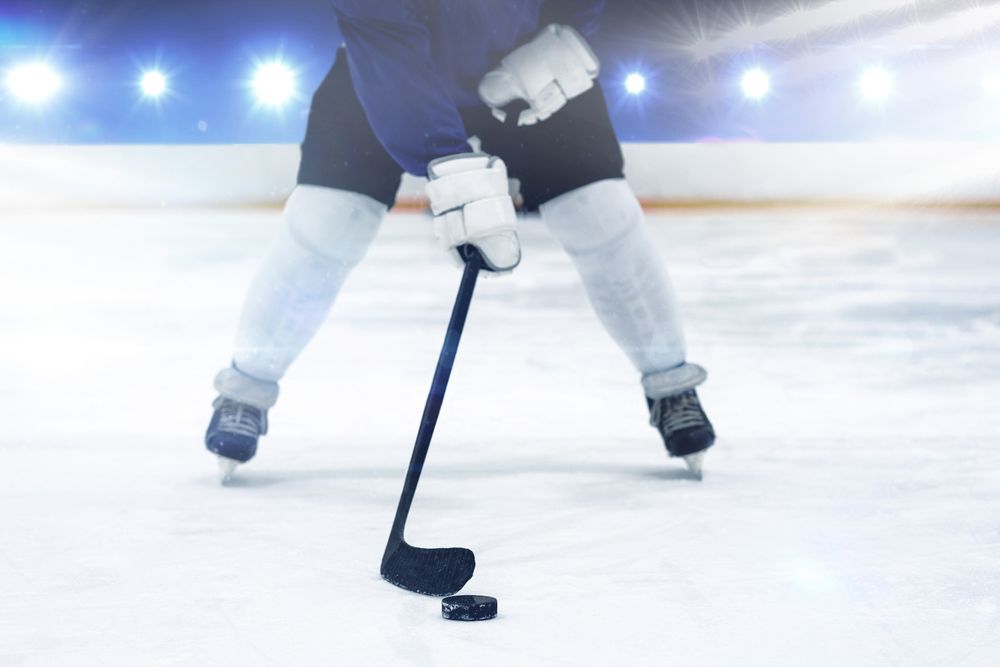Ice hockey, a challenging sport played on ice, requires mastering the art of ice skating. Surprisingly, individuals can learn the fundamentals of this sport within a few weeks.
Starting at a young age provides a stronger foundation, but late teenagers and adults can overcome the learning curve more quickly.
While mastery of ice hockey demands years of dedicated practice, individuals of all skill levels can enjoy the game, even joining beer leagues.
In this article, we explore the difficulty level of ice hockey and how to expedite the learning process.
Ice Hockey Difficulty Level
Ice hockey is widely recognized as a challenging sport to learn due to its unique combination of skills and the demanding nature of playing on ice. Mastering ice hockey techniques and training methods requires dedication and persistence.
The fundamentals of ice hockey can be learned in a few weeks, but true mastery of the sport takes years of practice. Starting age also plays a role in the learning process. Young children can begin learning to skate around 3-4 years old and can join organized leagues at 5 years old. Starting as a late teen or adult allows for quicker learning, with the basics being learned within a week or two.
Private skating lessons can accelerate learning and skill development. Regardless of age, ice skating ability is crucial for effective gameplay and should be prioritized in training.
With consistent practice and proper training methods, anyone can develop the skills necessary to excel in ice hockey.
Learning Time for Ice Hockey
Consistent practice and dedication are essential for mastering ice hockey, as learning time for the sport varies depending on individual effort and commitment. However, there are some general guidelines that can give an idea of the time it takes to learn ice hockey.
Here are three factors that can influence the learning time for ice hockey:
- Learning techniques: Effective learning techniques can significantly speed up the learning process. Using proper coaching, instructional videos, and drills focused on specific skills can help players develop their abilities more quickly.
- Skill development: The development of skills such as skating, stickhandling, shooting, and passing plays a crucial role in becoming proficient in ice hockey. Regular practice and targeted skill development exercises can expedite the learning process.
- Individual commitment: The level of dedication and commitment a player puts into learning ice hockey can greatly impact the learning time. Consistently practicing, attending training sessions, and seeking feedback from experienced players or coaches can accelerate skill acquisition.
Starting Age for Ice Hockey
Children can begin their ice hockey journey as early as 3-4 years old when they can start learning to skate. Starting at a young age has several benefits for youth hockey development.
It allows children to develop their skating skills and coordination early on, providing a solid foundation for future hockey skills. Starting young also allows for rapid improvement, as young children tend to be more adaptable and quick learners.
Additionally, starting at a young age gives children the opportunity to develop a passion for the sport and build lifelong friendships with teammates. However, it is important to note that starting age is not the sole determinant of success in ice hockey.
Players who start later in their teens or even as adults can still learn and enjoy the game, although the learning curve may be shorter compared to starting at a young age.
Youth Ice Hockey Starter Kit
Starting their ice hockey journey, young players can benefit from a comprehensive youth ice hockey starter kit. Here are three essential items that should be included in such a kit:
- Affordability: A youth ice hockey starter kit should be affordable, making it accessible to families of all income levels. It should contain equipment that is reasonably priced without compromising on safety or quality.
- Essential Equipment: The kit should include all the essential equipment needed for young players to start playing ice hockey. This may include items such as a helmet, shoulder pads, elbow pads, gloves, shin guards, skates, and a stick. It is important to ensure that the equipment fits properly to provide maximum protection and performance.
- Safety Features: The youth ice hockey starter kit should prioritize safety by including equipment with appropriate safety features. This may include helmets with face cages or full face shields, padding in key areas to protect against injuries, and skates with proper ankle support.
House Leagues and Beer Leagues
House leagues and beer leagues provide opportunities for players of all ages and skill levels to participate in organized ice hockey games. House leagues are typically geared towards children and teenagers, offering a more relaxed and developmental atmosphere. These leagues focus on skill-building, teamwork, and sportsmanship. On the other hand, beer leagues are recreational leagues for adults, often consisting of players with varying levels of experience. These leagues prioritize fun and camaraderie, allowing players to enjoy the game in a less competitive environment.
Here is a table highlighting the benefits of house leagues and the competitiveness of beer leagues:
| House League Benefits | Beer League Competitiveness |
|---|---|
| Developmental focus | Recreational atmosphere |
| Skill-building | Varying skill levels |
| Teamwork | Emphasis on fun and camaraderie |
| Sportsmanship | Less competitive environment |
Both house leagues and beer leagues offer unique experiences for ice hockey players, allowing them to participate in the sport and feel a sense of belonging within the hockey community.
Competing at Age 13
At age 13, aspiring hockey players can begin competing against others their age and gain valuable experience on the ice. This is an exciting time for young players as they take their skills to the next level and compete against more experienced players.
Here are three key points to consider when competing at age 13:
- Competing against experienced players: At this age, players may find themselves facing opponents who have been playing hockey for several years. While this can be intimidating, it also presents an opportunity to learn and grow. By challenging themselves against more experienced players, young athletes can improve their skills and develop a competitive edge.
- Rapid improvement at a young age: Starting hockey at age 13 allows for rapid improvement. The combination of physical growth, increased practice time, and exposure to higher levels of competition can lead to significant progress on the ice. It is during this period that players can develop key skills, such as skating, stickhandling, and game sense, which will lay the foundation for their future success in the sport.
- Valuable experience: Competing at age 13 provides valuable experience that will shape a player’s hockey journey. It offers the opportunity to learn important lessons about teamwork, resilience, and sportsmanship. Additionally, being part of a team and competing in games helps players develop their hockey sense and decision-making abilities in real-game situations.
Competing at age 13 is an important step in a young hockey player’s development. It offers the chance to face more experienced players, experience rapid improvement, and gain valuable experience that will shape their future in the sport.
Competing at Age 14
Competing at age 14 in ice hockey provides young players with the opportunity to further develop their skills and continue their growth in the sport. At this age, players may find themselves competing against more experienced players, which can be challenging but also beneficial for their development.
While starting at age 14 may mean that some players have already been playing for a few years, it is not too late to begin. To accelerate their learning and skill development, young players can consider taking private skating lessons. These lessons can help improve their skating technique, agility, and overall performance on the ice.
Competing at Age 15
Players at age 15 in ice hockey face unique challenges and opportunities as they continue to develop their skills and progress in the sport. Here are three key points to consider:
- Accelerating progress: Starting young in ice hockey provides numerous benefits. By beginning at a younger age, players have more time to develop their skating, stickhandling, and game sense. This early start allows for a solid foundation in the sport, which can lead to faster skill acquisition and overall improvement.
- Competition against experienced players: Competing at age 15 means facing opponents who may have 5-10 years of experience. While this can be challenging, it also presents an opportunity for growth. Playing against more experienced players can help accelerate the learning process by exposing young players to higher levels of competition and forcing them to adapt and improve their skills.
- Playing in a house league: Starting in a house league is a recommended option for 15-year-olds. This provides a supportive and inclusive environment where players can continue to develop their skills and gain valuable game experience. Additionally, considering private skating lessons can further accelerate learning and skill development.
With proper guidance and dedication, players at age 15 can navigate these challenges and seize the opportunities presented to them as they progress in their ice hockey journey.
Learning Curve for Adults
For adults, learning ice hockey presents a challenging yet rewarding journey. Unlike children who have the advantage of starting at a young age, adults may feel a sense of urgency to catch up. However, adults also have unique advantages when it comes to learning the sport.
By utilizing adult learning strategies and embracing the benefits of starting later in life, adults can expedite their progress on the ice. One key strategy is to focus on building a strong foundation in ice skating. With regular practice and dedication, adults can learn the basics of ice skating within a few weeks and be ready to incorporate a hockey stick into their skating after a few months.
Additionally, adults can take advantage of stick and puck sessions, join drop-in or pick-up games, and practice stickhandling at home to further enhance their skills. While it may take several months to be ready for adult hockey leagues, the journey of learning ice hockey as an adult can still be enjoyable and fulfilling.
Time to Join Adult Hockey League
Joining an adult hockey league requires careful consideration and the development of essential skills. When deciding when to join, it is important to take into account the time it takes to acquire the necessary skills and the benefits of playing ice hockey as an adult.
Here are three key points to consider:
- Skill Development: Before joining an adult league, it is crucial to spend time practicing and honing your ice hockey skills. This includes attending stick and puck sessions, participating in drop-in or pick-up games, and practicing stickhandling regularly. It may take around 3-6 months of consistent practice to feel confident and ready for adult hockey.
- Physical Preparation: Playing ice hockey as an adult requires physical fitness and endurance. Prior to joining a league, it is advisable to engage in regular exercise to improve stamina, strength, and flexibility. This will help prevent injuries and enhance overall performance on the ice.
- Camaraderie and Enjoyment: Joining an adult hockey league provides an opportunity to be part of a community of like-minded individuals who share a passion for the sport. Playing ice hockey as an adult offers not only the physical benefits of exercise but also the social benefits of camaraderie, teamwork, and the enjoyment of playing a competitive sport.
Importance of Ice Skating in Hockey
Ice skating is an essential skill in ice hockey, as it heavily impacts the performance of players in offense, defense, and goaltending. Skating ability is crucial for playing the game effectively, and NHL players who excel are also exceptional skaters. The impact of skating on game performance is significant, as it allows players to maneuver quickly on the ice, change directions, and maintain balance while executing various hockey skills.
Improving skating technique is of utmost importance in hockey. Players must focus on developing proper stride mechanics, edge control, and agility. By honing these skills, players can accelerate faster, maintain speed, and outmaneuver opponents. In offense, skilled skaters can create scoring opportunities by eluding defenders and making quick cuts to the net. Defensively, strong skating allows players to stay with opponents, close gaps, and disrupt plays. Goaltenders also rely on their skating ability to position themselves effectively and make timely saves.
Frequently Asked Questions
What Are Some Tips for Adults Learning to Play Ice Hockey?
Tips for adults learning to play ice hockey include attending stick and puck sessions, participating in drop-in games, practicing stickhandling, and focusing on improving skating ability. Avoid common mistakes by seeking professional instruction and gradually building skills.
Is It Possible to Learn Ice Hockey Without Knowing How to Ice Skate?
Learning ice hockey without skating skills is not recommended, as ice skating is the most important skill in the sport. However, with dedicated practice and proper coaching, it is possible to develop both skating and hockey skills simultaneously.
How Long Does It Typically Take for a Child to Become Proficient at Ice Skating?
It typically takes a child several weeks to become proficient at ice skating. However, starting at a young age provides a better foundation. Learning ice hockey as an adult has a shorter learning curve than for children.
Are There Any Specific Skills or Equipment That Are Important for Youth Ice Hockey Players?
Proper protective gear is crucial for youth ice hockey players to ensure their safety on the ice. Training drills focusing on skating, stickhandling, and shooting skills are essential for their development and success in the sport.
What Are Some Strategies for Accelerating the Learning Process in Ice Hockey?
Effective training strategies for accelerating the learning process in ice hockey include focusing on skating skills, dedicating regular practice time to stickhandling, participating in stick and puck sessions, and engaging in drop-in or pick-up hockey games after a few months of practice.
Conclusion
In conclusion, ice hockey is undeniably a challenging sport to learn, with the mastery of ice skating being the key foundation. Starting at a young age provides a more comprehensive understanding and a stronger foundation, but it is still possible for late teenagers and adults to learn the game with a quicker learning curve.
Regardless of the starting age, mastering ice hockey requires years of dedicated practice. However, individuals can still enjoy the game at various skill levels, including beer leagues, even if they start playing as adults.
As the saying goes, learning to play ice hockey is like starting from scratch, but once you glide on the ice, a world of possibilities opens up.









